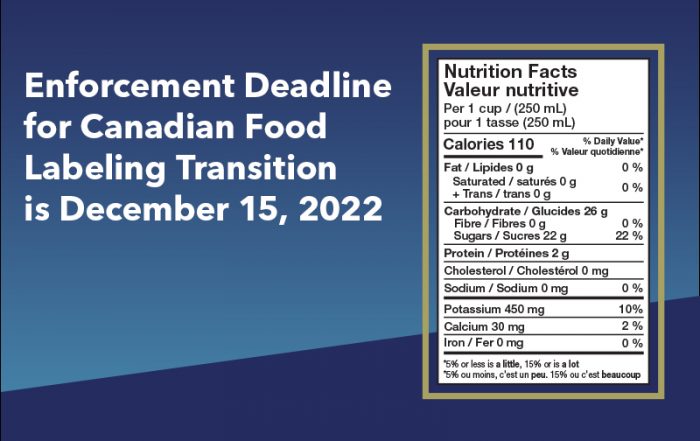Gluten-Free Claim and Related Compliance Verification
Complete and accurate gluten information on food product packaging is crucial for individuals living with celiac disease or non-celiac gluten sensitivities. According to the Canadian Celiac Association, one percent of the world’s population is at risk for celiac disease and another 2-5% for gluten disorders.
There is a large amount of information available to the public regarding gluten allergy, celiac disease, and gluten-free claim requirements which may at times appear overwhelming to consumers. At the same time, manufacturers and importers need to be clear on regulations, what is expected from them, and ensure that they consistently meet legal requirements for foods with gluten-free claims.
Our goal with this article is to provide a high-level overview of gluten-free requirements and gluten-free claim verification testing as it applies to food manufacturers and importers.
Protecting Consumers
Health Canada takes a two-prong approach in keeping the public safe. First, through enforcing clear, accurate labeling to protect consumers, and gluten-free verification testing for manufacturers and importers to help ensure that their products consistently meet gluten-free standards.
To make consumer food labels clearer and easier to understand, Health Canada requires gluten sources to be declared by their common name (i.e., wheat, barley, oats, etc.) for the benefit of affected consumers to be able to determine whether a product contains gluten or not. This applies to both “Contains” statements if products contain gluten, as well precautionary (“May contain”) statement in case where potential cross contamination may exist in facilities that also handle wheat or manufacture on equipment that is used for processing wheat.
CFIA expects compliance verification testing by all food manufacturers and importers even if their facility does not handle gluten ingredients, or if products are made on dedicated production lines. The goal here is to ensure that gluten content does not exceed gluten tolerance limits which we discuss later in the article.
Gluten Allergies and Celiac Disease
Celiac disease (aka gluten intolerance) is a specific autoimmune digestive disorder of the small intestine. In celiac disease, the immune system reacts against gluten, a protein found in wheat and other source of gluten, causing damage to the villi within the intestine and loss of surface area for absorbing nutrients
There are more than 200 known celiac disease symptoms which may occur in the digestive system or other parts of the body. The symptoms can range from abdominal bloating, chronic diarrhea, and constipation to depression, seizures, infertility, and arthritis. Some people develop celiac disease as a child, others as an adult. Regardless, the reason for developing it is still unknown.
In addition to “classical celiac disease” (patients have signs and symptoms of malabsorption, including diarrhea, steatorrhea, and weight loss or growth failure in children) and “non-classical celiac disease” (patients may have mild gastrointestinal symptoms without clear signs of malabsorption or may have seemingly unrelated symptoms), there is such thing as “silent celiac disease” (asymptomatic celiac disease; patients do not complain of any symptoms, but still experience villous atrophy damage to their small intestine).
The number of ways celiac disease can affect patients, combined with a lack of training in medical schools and primary care residency programs, contributes to the poor diagnosis rate in the United States. Currently it is estimated that 80% of the US celiac disease population remains undiagnosed.
In 2012, it was estimated by Health Canada that Celiac disease affects approximately 1% of the population, or 340,000 Canadians. A study showed that Canada is the country with the greatest increase (about 35%) in the incidence and prevalence of celiac disease over the past decades (Lerner et al. 2015).
How much gluten can be tolerated without symptoms?
Tolerances for acceptable levels of gluten in food products can vary depending on the country. Even though Canada is consistent with other global standards, there is yet to be a universal consensus on acceptable levels of gluten and standardization of labels. This is especially important for affected individuals that travel.
Food and Agriculture Organization (FAO) & World Health Organization (WHO)
FAO and WHO under Codex Alimentarius, specifies that in order for a food to be considered as “gluten-free”, gluten levels should not exceed 20 mg/kg in total, based on the food as sold or distributed to the consumer (i.e., 20 parts per million). Per the same document, such food must either contain none of the gluten sources (wheat (i.e., all Triticum species, such as durum wheat, and spelt) and Khorasan wheat (also marketed under different trademarks such as KAMUT), rye, barley, oats or their crossbred varieties) or have been specially processed to remove gluten if contains such ingredients, and the gluten level does not exceed 20 mg/kg in total.
Health Canada
Health Canada applies the same approach as FAO & WHO for foods to be considered gluten-free. Gluten protein levels must be below 20 ppm, and do not represent health risks to consumers suffering from celiac disease.
Canadian Label Requirements for Gluten-Free Claims
Food companies need to be mindful about ensuring that their product labels are accurate. Canadian Food and Drug Regulations (FDR) clearly states that: “It is prohibited to label, package, sell or advertise a food in a manner likely to create an impression that it is a gluten-free food if the food contains any gluten protein or modified gluten protein, including any gluten protein fraction, referred to in the definition “gluten”.
FDR also defines gluten as:
- either “any gluten protein from the grain of any of the following cereals or the grain of a hybridized strain created from at least one of the following cereals: barley, oats, rye, triticale, or wheat, kamut, or spelt”; OR
- “Any modified gluten protein, including any gluten protein fraction, that is derived from the grain of any of the mentioned cereals or the grain of a hybridized strain of them”
It is concluded from the stated tolerance limit and FDR approach that a food can be deemed Gluten-Free if the gluten content of it does not exceed 20 parts per million.
Testing Products for Gluten
Canadian Food Inspection Agency (CFIA) expects manufacturers and importers of gluten-free foods to make every reasonable effort to minimize the presence of gluten through cross-contamination. Similarly, to other regulatory claims, gluten-free claims must also be verified regularly to ensure the effectiveness of the control measures taken by the food manufacturer. It is critical that gluten testing is conducted using an appropriate quantitative technique to scientifically substantiate the gluten free claim on food products.
Various testing kits are commercially available to conduct routine gluten testing; however, in many instances such as due to the complex nature of food products and/or extensive ingredients processing, gluten test results are not always reliable. There are different types of quantitative enzyme-linked immunosorbent assay (ELISA) testing kits that are currently available for the determination of the immuno-toxic fraction of gluten in food samples, so testing kit suitability for a given product matrix is another important factor for consideration. According to the FDA, reliability of the gluten testing results in certain foods can be questionable for example if the food has been partially broken down into smaller protein fragments through fermentation and hydrolysis.
An analytical laboratory can help accurately assess the presence allergens as part of an effective quality control program and provide confidence that the products are safe.
Can we help? Contact Us.
At MCS Associates, our team of food regulatory affairs experts with several years of experience in conducting risk assessment for food operations with wide range of commodities. Contact our food safety experts to support your Compliance Verification and labeling requirements..
References:
- Celiac Disease Foundation https://celiac.org/about-celiac-disease/symptoms-of-celiac-disease/
- Canadian Digestive Health Foundation: Statistics on Celiac Disease https://cdhf.ca/digestive-disorders/celiac-disease/statistics-on-celiac-disease/
- FAO Codex: Standard for Foods for Special Dietary Use for Persons Intolerant to Gluten https://www.fao.org/fao-who-codexalimentarius/sh-proxy/es/?lnk=1&url=https%253A%252F%252Fworkspace.fao.org%252Fsites%252Fcodex%252FStandards%252FCXS%2B118-1979%252FCXS_118e_2015.pdf
- Health Canada’s Position on Gluten-Free Claims https://www.canada.ca/en/health-canada/services/food-nutrition/food-safety/food-allergies-intolerances/celiac-disease/health-canada-position-gluten-free-claims.html
- Canadian Celiac Association https://www.celiac.ca/living-gluten-free/gluten-free-certification-program/
- CFIA: Compliance and enforcement of gluten-free claims https://inspection.canada.ca/food-label-requirements/labelling/industry/allergens-and-gluten/gluten-free-claims/eng/1340194596012/1340194681961








